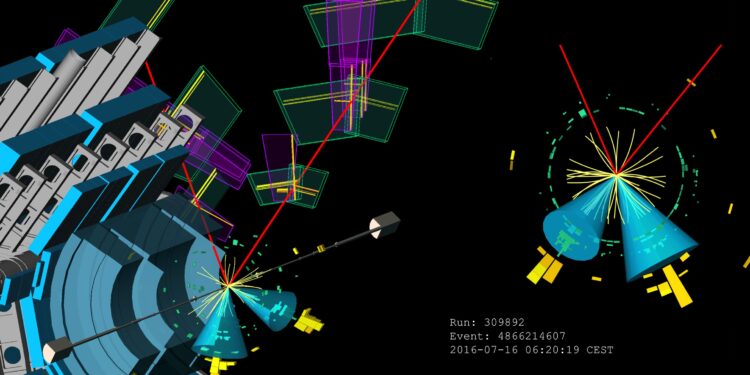Candidate event for the ZH → μμ cc process, where a Z boson and a Higgs boson decay into two muons (red traces) and two charm-marked jets (blue cones). Credit: ATLAS collaboration
One of the central goals of the ATLAS Higgs physics program is to measure, with increasing precision, the strength of the interactions of the Higgs boson with fermions and elementary bosons.
According to the theory of electroweak symmetry breaking, these interactions are responsible for the generation of particle masses. The interaction strengths can be determined by precisely measuring the production of the Higgs boson via the particles concerned and their decay.
At the recent International Conference on High Energy Physics (ICHEP) 2024, the ATLAS collaboration presented improved measurements of the strength of the Higgs boson’s interactions with the three heaviest quarks: top, bottom, and charm.
The new results are based on a reanalysis of LHC Run 2 data taken between 2015 and 2018 with significantly improved analysis methods, including improved jet labeling.
But what are jets, and why do we need to label them? When the Higgs boson decays into a pair of quarks, each quark breaks up, creating a collimated jet of particles (mostly hadrons) that can be observed in the detector. The goal of jet labeling is to determine which type (or “flavor”) of quark produced a given jet through a detailed analysis of the jet’s properties.
Using new jet-labeling techniques (or “flavors”) tailored to charm quarks and bottom quarks, ATLAS researchers were able to significantly increase the sensitivity of their analyses. With further analysis improvements, they increased the sensitivity to H→bb and H→cc decays by 15% and a factor of three, respectively.
Updated measurements of Higgs boson production in association with a W or Z boson and decays to a pair of bottom or charm quarks have allowed the first observation of the WH,H→bb process with a significance of 5.3σ and a measurement of ZH,H→bb with a significance of 4.9σ. The Higgs boson decay to c quarks is suppressed by a mass factor of 20 compared to the decay to b quarks and is therefore still too rare to be observed.
ATLAS sets an upper limit of 11.3 times the speed of the VH, H→cc process relative to the Standard Model prediction. These results are the most accurate probes of these processes to date and are consistent with the Standard Model.
A new measurement of the Higgs boson interaction with the top quark focused on the production of the Higgs in association with two top quarks and its subsequent decay into a pair of bottom quarks. This complex process has a very complex final state and suffers from significant background noise.
The new analysis, which benefits from a refined understanding of the dominant background processes involving top quarks, improved the sensitivity by a factor of two and measured a signal strength for ttH, H→bb production of 0.81 ± 0.21, compared to the Standard Model prediction.
Further improved analysis techniques and new data from the ongoing third phase allow these interactions to be measured with even greater precision. These advances in the search for H→cc reinforce the expectation of the High-Luminosity Large Hadron Collider (HL-LHC), where the detection of this process enters the realm of feasibility.
More information:
For more information, see the ATLAS briefings here and here.
Quote: ATLAS probes Higgs interaction with heavier quarks (2024, September 9) retrieved September 9, 2024 from
This document is subject to copyright. Apart from any fair dealing for the purpose of private study or research, no part may be reproduced without written permission. The content is provided for informational purposes only.



